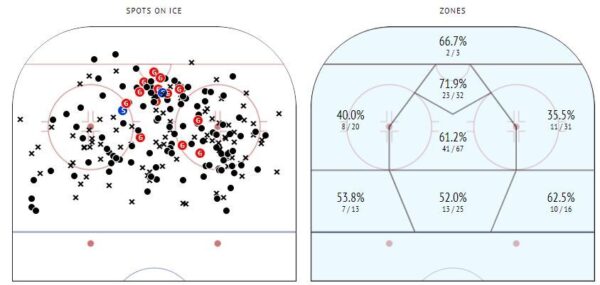Analytics Approach: Fyodor Svechkov
In this edition of FCHockey’s Analytics Approach, I tracked the puck possession metrics for center Fyodor Svechkov, playing for the Ladia Togliatti of the VHL, with some time spent in the MHL, and representing Russia at the 2021 IIHF World Under-18 Championship.
I tracked four recent games by Svechkov and totaled up his metrics to see what patterns developed as I watched him play. The games tracked are noted below and all metrics are tabulated at 5-on-5 even strength:
December 24th, 2020 against Toros Neftekamsk
January 25th, 2021 against Dynamo MO
January 31st, 2021 against Yuzhny Ural Orsk
May 27th, 2021 against United States (U18 Worlds)
Player: Fyodor Svechkov (#9)
Team: Ladia Togliatti (VHL)
FCHockey Rank: 18
Current Season Stats: 38 GP | 15 PTS (five Goals, 10 Assists)
Position: Center/Wing
Shoots: Left
D.O.B.: 04/05/2003
Height / Weight: 6’0” / 187 lbs
Svechkov is a very complete player that has an impressive two-way game that is years ahead of most prospects at this age. He has the versatility to play the wing, but seems to be most natural at center where his defensive ability has the greatest impact.
Entering spring, Svechkov appeared to be a fringe first-round selection in the 2021 NHL Draft, though raised his draft stock significantly with his strong play for Russia’s silver performance at the Under-18s. Looking the part of a dominant, play-driving center who suffocated his opposing line, Svechkov put up 10 points (four goals, six assists) in just seven games.
A key part of this Analytics Approach is how well the profiled player is able to impact puck possession. This includes actions by the prospect both with and without the puck.
In the clip below, Svechkov plays excellent angles on the puck carrier to prevent them from going behind the net. As the puck goes back out to the point, he again uses his positioning to prevent the defenseman from walking in closer to the net or the middle of the ice.
Svechkov’s ability to keep the play to the outside and prevent the opponent from getting close to the high-danger area of the ice is an advanced defensive technique at this age. With Svechkov able to influence where the puck goes in his own end, he’s able to limit scoring chances and opponent possession time.
In the clip above, Svechkov does a great job of using his body to win a puck battle in the corner in support of his defensemen. It’s important to note that Svechkov is patient while fighting for the puck and isn’t trying to aimlessly fire the puck around the boards.
Instead, Svechkov finds an opportunity to exit the battle with possession of the puck and skates it behind his net. He then looks up ice and finds an outlet pass to a teammate and exits the zone with controlled possession. This is a simple play that has a profound impact on how often Svechkov’s team has control of the puck and something he consistently does.
What separates Svechkov’s defensive play from others is how he’s able to win puck battles in any area of the ice. Svechkov never quits on a puck battle and, as evidenced in the clip above, he is able to continue forcing the puck towards the blue line in his own zone before finally gaining control and exiting with possession.
Svechkov continues to carry the puck through the neutral zone and into opposing territory before setting up a scoring chance. Svechkov’s mentality to win the battle and hang onto the puck is a play driving trait that frequently tilts the puck possession metrics in his team’s favor while he’s on the ice.
Another strength in Svechkov’s game is his anticipatory skills to intercept pucks in the neutral zone and transition the other way. In the clip above, Svechkov does a great job of finding an area in the neutral zone that enables him access to multiple passing lanes. As he jumps the play to intercept the pass, he already has good speed to enter the zone with possession.
Below is a glossary of terms used for this tracking effort which should look familiar to those with some experience in analytics. The focus in this article is on puck possession and the shot attempts associated with them to better understand how impactful a player is on shot attempts for and against.
Glossary:
SA For – Shot Attempts For
SA Against – Shot Attempts Against
CF% – Percentage of Shot Attempts For (Team and Opponent)
SC For – Scoring Chances For
SC Against – Scoring Chances Against
SCF% – Percentage of Scoring Chances For (Team and Opponent)
Primary Shot Assist – Pass that leads to a Shot Attempt
Puck Possession Metrics
Thus far, Svechkov has graded out as the highest success rate on controlled zone exits and entries in this Analytics Approach series. Using a dump in or out as a last resort only, Svechkov has a natural ability to carry the puck through all three zones.
Using powerful strides, Svechkov likes to start his exits behind the net as he builds up speed to complete the exit with speed. This helps to get defenders to back off and open up some space for him to skate through the neutral zone and into opponent territory.
As evidenced above, Svechkov again uses his ability to take away the puck in the neutral zone and enter the zone with possession. Keeping his feet moving as he breaks around the defender, he protects the puck and begins to drive towards the net for a shot attempt.
It’s important to note that on this play, it would be easy for Svechkov to dump it in but his instinct to hang onto the puck and find his way to the high danger area. Driving the play while controlling the puck is a natural ability by Svechkov and why he has such positive on ice impacts per the underlying metrics.
Team Shot Attempt Metrics
As Svechkov dominated the possession stats section of this article, it should be no surprise that his team was heavily favored in the shot attempt metrics. With Svechkov being such a strong defender who can limit shot attempts against, it was predictable that his CF% was extremely high at just over 75 percent.
From a scoring chance perspective, Svechkov also had a high percentage in favor of his team. However, the volume of scoring chances was not very high given the amount of time he spent in the offensive zone. If there’s one thing to knock about Svechkov’s game it’s that he doesn’t offer as much skill as other players in this class.
While Svechkov’s contributions to positive shot attempt metrics is important, his lack of high-end skill to generate more scoring chances limits his ceiling at the NHL level to more of a very high-end second line center.
Individual Shot Attempt Metrics
Having a direct contribution on 37 percent of his team’s shot attempts, Svechkov is certainly having a positive impact in the offensive zone. Taking 15 of these attempts himself, Svechkov showed a bias of taking shots rather than setting them up.
To give a better view of where Svechkov is taking his shots from, InStat Hockey has a shot map for this season to date. All shot attempts in the map below are at 5-on-5 and include shots on goal as well as shot attempts that missed the net or were blocked.

Looking at the ‘home plate’ area of the chart, Svechkov took 56 percent of his total attempts in this high danger area, with 36 percent of those attempts hitting the net. While it’s no surprise that all of his goals came in this area, what’s interesting is the cluster of goals Svechkov scored in the crease area which show his ability to play in the congested area of the ice.
In the clip below, Svechkov is persistent in working his way towards the net, even though he can shoot from further out. Driving to the net, he takes a low shot from the high danger area that creates a rebound for an easy goal by his teammate.
On his next goal, Svechkov finds open ice in the high slot and keeps himself open for a pass before releasing a quick shot low to beat the goaltender. While his shot isn’t the flashiest, there’s a method about when and where Svechkov releases the puck that can make him an effective goal scorer.
There’s a lot to like about Svechkov’s game and he is looking to be one of the safest picks in this draft with a high floor due to his excellent hockey IQ. Driving play with control of the puck and having a polished defensive game will enable Svechkov to transition to the NHL sooner than most prospects from this draft class. Stylistic comparisons to Anton Lundell can be made, though Svechkov doesn’t have the same offensive skills at that level yet.
At this point in time, Svechkov looks like a lock to be a 1st round pick in the 2021 NHL Draft with some potential to go in the 10-15 range.

